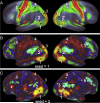Human Connectome Project informatics: quality control, database services, and data visualization
- PMID: 23707591
- PMCID: PMC3845379
- DOI: 10.1016/j.neuroimage.2013.05.077
Human Connectome Project informatics: quality control, database services, and data visualization
Abstract
The Human Connectome Project (HCP) has developed protocols, standard operating and quality control procedures, and a suite of informatics tools to enable high throughput data collection, data sharing, automated data processing and analysis, and data mining and visualization. Quality control procedures include methods to maintain data collection consistency over time, to measure head motion, and to establish quantitative modality-specific overall quality assessments. Database services developed as customizations of the XNAT imaging informatics platform support both internal daily operations and open access data sharing. The Connectome Workbench visualization environment enables user interaction with HCP data and is increasingly integrated with the HCP's database services. Here we describe the current state of these procedures and tools and their application in the ongoing HCP study.
Copyright © 2013 Elsevier Inc. All rights reserved.
Figures










References
-
- Aspera [March 11, 2013];Aspera fasp High Speed Transport. 2013 at http://asperasoft.com/fileadmin/media/Asperasoft.com/Resources/White_Pap....
-
- Barch DM, Burgess G, Harms MP, Petersen SE, Schlaggar BL, Corbetta M, Glasser MF, Curtiss SW, Dixit S, Feldt C, Nolan D, Bryant E, Hartley T, Footer O, Bjork JM, Poldrack R, Smith S, Snyder AZ, Van Essen DC. Function in the human connectome: Task-fMRI and individual differences in behavior. Neuroimage. 2013 (Special issue on Mapping the Connectome) - PMC - PubMed
-
- Biswal B, Yetkin FZ, Haughton VM, Hyde JS. Functional connectivity in the motor cortex of resting human brain using echo-planar MRI. Magn Reson Med. 1995;34:537–541. - PubMed
Publication types
MeSH terms
Grants and funding
LinkOut - more resources
Full Text Sources
Other Literature Sources
Miscellaneous

